H.B. Reneau's Blog, page 2
February 18, 2025
The Art of the Underworld: Writing Dark, Immersive Worlds That Transform Your Characters
You’re standing at the rusted gates of the docklands, the salty air thick with the scent of damp wood and decay. Behind you, the city hums with life—voices calling across the piers, the rhythmic creak of ships shifting in their moorings. But ahead? A yawning stone archway, half-swallowed by ivy, leading down into darkness.
The steps beneath your boots are slick with algae. Somewhere ahead, water drips, echoing against unseen walls. The deeper you go, the closer the air presses in, stale and briny, heavy with the weight of things long buried.
This is the City Beneath.
This is an underworld.
And if you’re crafting your own, you want it to feel like this—like crossing a threshold into another world, one both thrilling and treacherous. Whether you’re writing a literal underground city (like the one in The Remnant) or just a metaphorical descent into the seedy underbelly of a society, the goal is the same: to make your readers feel like they’re walking those tunnels themselves.
So, let’s talk about how to do that.
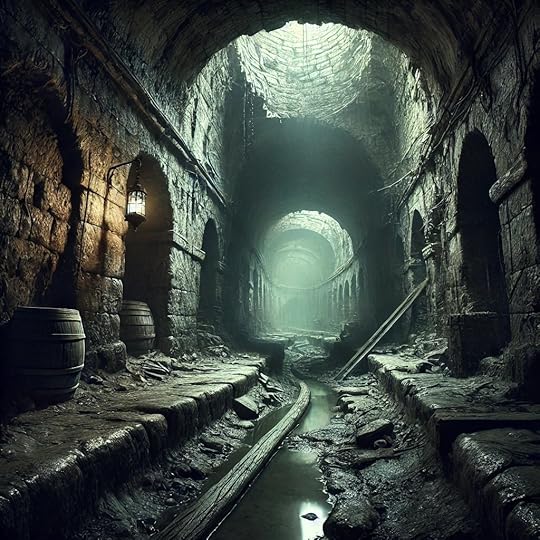
Step One: Build Your Underworld, Layer by Layer"The City Beneath was a world of shadows and secrets, where the past wasn’t so much forgotten as buried alive, left to decay in the dark while life continued overhead."
The Remnant
The best fictional underworlds don’t just appear—they evolve. In The Remnant, the City Beneath wasn’t planned. It was built over, each new generation entombing the last in layers of forgotten streets and abandoned corridors.
This organic history makes it feel real.
If you’re designing an underworld, think about:
Why does it exist? Was it intentional (catacombs, sewers, secret tunnels) or accidental (abandoned ruins, collapsed infrastructure, nature reclaiming lost places)?How has it changed? The City Beneath was once part of the Cross-Sea Lands, but as the tides rose, people built higher. The lower levels became uninhabitable… until the desperate and the cunning moved in.Who lives there now? Not just physically, but socially. Is it a place of exile? A criminal haven? A hidden refuge?And let’s be real—if your setting doesn’t have dripping water, flickering lanterns, and echoes stretching into the void, is it even a proper underworld?
Lore from The RemnantAt first, the Cross-Sea Lands were just a collection of dockside settlements, built close to the water for ease of trade. But the tides were relentless, rising higher each year, and so the people built up—stacking streets atop older ones, using the buried layers as foundations for the next. Over time, what had once been vibrant neighborhoods became sealed off, sunless corridors, abandoned as the city continued to expand.
But nothing stays empty forever.
The desperate moved in first—those too poor to afford homes in the rising city above. Then came the opportunists—smugglers and outlaws who thrived in the forgotten depths. And finally, the City Beneath took on a life of its own, evolving into a shadow society with its own rules, factions, and power struggles.
In The Remnant, the City Beneath wasn’t planned, but it became indispensable. Its tunnels now serve as smuggling routes, its ruins as safe havens for the displaced. The surface world depends on it, even as it pretends it doesn’t exist.
The City Beneath also still carries the marks of its past. Grand stone archways once led to noble houses, now nothing more than crumbling skeletons. Algae blooms in stagnant pools where fountains once ran clear. And in the deepest tunnels, where no light has touched for centuries, secrets remain untouched—waiting for someone brave (or foolish) enough to find them.
"A place where no light reached, where the past lay buried beneath centuries of stone and salt. The air was thick with the scent of brine and decay, and every step sent echoes stretching endlessly into the dark."
The Remnant

Step Two: Make It Dangerous“Then came the sound of breaking glass, of shattering stone, of everything solid giving way at once . . . Basha’s last thought wasn’t of falling—it was of Chiko’s hand still gripping hers, refusing to let go even as the shadows rushed up to meet them.”
The Remnant
A good underworld isn’t just spooky window dressing—it’s a threat.
In The Remnant, the City Beneath isn’t just a place where criminals hide. It’s a living hazard.
Floodwaters rise unexpectedly, swallowing entire corridors.Cave-ins are common, the weight of the city above pressing down.Darkness is absolute. If your lantern goes out, good luck finding your way back.But the biggest danger? The people.
Enter the Whispering Grotto—a tavern where smugglers, mercenaries, and thieves trade more than just coin. Basha learns the hard way that down here, alliances are shaky, debts last a lifetime, and betrayal comes cheap.
So when you’re crafting your underworld, ask:
What’s physically dangerous about it? Are there unstable walkways? Air that’s slowly poisoning people? Tunnels that shift?What’s socially dangerous? Who controls the underworld? What laws (or lack thereof) shape interactions?How does your protagonist survive it? Is it skill, luck, or sheer audacity keeping them alive?Because if your underworld isn’t trying to kill your characters, you’re doing it wrong.
Lore from The RemnantIn The Remnant, Basha quickly learns that the City Beneath isn’t a place you can just navigate on instinct. It’s a world that punishes the overconfident. She nearly drowns when an unexpected tide rushes through a tunnel. She watches the ground vanish beneath someone who took a wrong step on rotting scaffolding. And when she finds herself lost in the dark, she realizes the most terrifying thing about the City Beneath isn’t what you see—it’s what you don’t.
A crumbling ruin built into the bones of an old temple, the Whispering Grotto is the one place in the City Beneath where everyone crosses paths. It’s not just a tavern—it’s a market, a battleground, a graveyard waiting to happen. Deals are made in hushed voices over stolen drinks. Debts are settled in dark corners with whispered threats or drawn knives. When Basha first enters the Grotto, she thinks she’s untouchable—her name carries weight in the world above. But she learns fast: names mean nothing here. The first lesson of the City Beneath? No one is safe. Not even her.
The strong make the rules.The cunning survive.The desperate get used.No one comes to the City Beneath without a reason. And no one leaves unchanged.

Step Three: Use It as a Metaphor“Above her head, the paths of her ancestors rose in layers like the rings of a tree, each one marking another year the waters had tried to claim them . . . while the oldest streets lay sealed in the dark, carrying a legacy the powerful were happy to forget.”
The Remnant
The best settings aren’t just places—they mean something.
In The Remnant, the City Beneath is more than just a cool backdrop for smuggler showdowns and narrow escapes. It’s a reflection of the world above.
The wealthy literally live above the poor.The powerful pretend the underworld doesn’t exist—until they need something from it.The City Beneath is a place of exile, but also of rebellion.If your story has an underworld, use it to say something about your world as a whole. Does it represent the forgotten parts of society? The consequences of unchecked greed? The resilience of those cast aside?
A setting with meaning hits harder.
If you’re writing an underworld, ask yourself:
 What does it say about your world’s social structure? (Who lives above vs. below?)
What does it say about your world’s social structure? (Who lives above vs. below?) What secrets does it hold? (Lost knowledge? Forbidden truths?)
What secrets does it hold? (Lost knowledge? Forbidden truths?) How does it challenge your protagonist? (Will they embrace the darkness? Or fight to rise above it?)
How does it challenge your protagonist? (Will they embrace the darkness? Or fight to rise above it?)
Centuries ago, the Cross-Sea Lands built upward with each new tide, but not everyone could afford to rise. As the noble houses constructed their manors on higher ground, whole districts were left abandoned beneath them. The people who remained were those without the means—or the influence—to climb higher.
In time, the City Beneath became a dumping ground for more than just old buildings. Political exiles, disgraced merchants, criminals—all were cast into the depths, left to fend for themselves.
The world above refuses to acknowledge the City Beneath. It’s an inconvenient truth, a stain on their illusion of order. But when they need something—contraband, a secret passage, an inconvenient rival disposed of—they come crawling back.
When Basha first descends, she’s stunned by what she sees—crumbling mansions and broken archways, evidence that this place was once just as grand as the city above. But now, the chandeliers have rusted, the courtyards have flooded, and those who still live here have learned to thrive in the ruins of what others have abandoned.
In The Remnant, Basha enters the City Beneath looking for a way out. But what she finds instead is a choice:
 Ignore the truth she’s discovered and return to the life she knew.
Ignore the truth she’s discovered and return to the life she knew. Or use what she’s learned in the underworld to tear down the world above.
Or use what she’s learned in the underworld to tear down the world above.
Because the thing about an underworld is . . .
Not everyone wants to leave.
Some want to drag the whole world down with them.

Step Four: Make Your Characters Change Because of It“Every stolen moment here was a rebellion against the weight of duty that had settled on her ever since Sara left—a mantle she’d never wanted, never asked for.”
The Remnant
A great underworld isn’t just a place your characters visit. It’s a trial they have to survive.
For Basha, descending into the City Beneath isn’t just about hiding away from her responsibilities. It’s about stepping into a world where her family name means nothing. Where she has to earn her place. Where she learns, for the first time, that she’s capable of more than she ever thought possible.
So, ask yourself:
What does your protagonist believe before entering the underworld?How does the experience challenge those beliefs?What parts of them die in the dark? And what parts are reborn?The best underworlds transform the people who enter them.
Because in the end, survival isn’t about escaping the underworld.
It’s about becoming someone who can survive anywhere—even in the light.
Lore from The RemnantBefore she stepped into the darkness, Basha believed:
 That power comes from status—from names, from alliances, from the weight of a family’s reputation.
That power comes from status—from names, from alliances, from the weight of a family’s reputation. That the world has rules—even if they are unfair, even if they serve the powerful, there is still a structure to them.
That the world has rules—even if they are unfair, even if they serve the powerful, there is still a structure to them. That she knows who she is—reckless but clever, privileged but capable, a fighter who never backs down.
That she knows who she is—reckless but clever, privileged but capable, a fighter who never backs down.
She thinks she’s prepared.
She isn’t.
Everything Basha believed before is turned against her below.
 Power doesn’t come from status—it comes from control. The City Beneath operates on a different kind of currency. Power is who owes you favors, who fears you, who knows your weaknesses and keeps them close.
Power doesn’t come from status—it comes from control. The City Beneath operates on a different kind of currency. Power is who owes you favors, who fears you, who knows your weaknesses and keeps them close. The world has no rules—only those you enforce. If Basha wants to survive, she has to learn the new game fast. There’s no justice here. No safety net. No second chances.
The world has no rules—only those you enforce. If Basha wants to survive, she has to learn the new game fast. There’s no justice here. No safety net. No second chances. She doesn’t know who she is—yet. Stripped of everything familiar, she starts to realize she’s more than just her family’s reckless disappointment. But who is she, if not the girl she used to be?
She doesn’t know who she is—yet. Stripped of everything familiar, she starts to realize she’s more than just her family’s reckless disappointment. But who is she, if not the girl she used to be?

Step Five: Emerging into the Light“She’d told herself she would forget, that she’d leave the darkness below and never look back. Yet the weight of those secrets clung to her like a damp cloak, refusing to be cast aside so easily.”
The Remnant
Eventually, your character has to leave the underworld (or at least try). And that moment—stepping back into the sun—should mean something.
Maybe they emerge stronger.Maybe they’re carrying secrets that will shake the world above.Maybe they don’t want to leave at all.But whatever happens, the underworld should linger. Basha may leave the City Beneath, but its shadows never fully leave her.
And that’s what makes a great underworld—not just its darkness, but the way it changes those who dare to walk it.
Lore from The RemnantThe City Beneath strips Basha down—but in that breaking, something new begins to form.
 What Dies:
What Dies:
 What’s Reborn:
What’s Reborn:
Now it’s your turn!
What’s your favorite underworld in fiction? (Mordor? The Mines of Moria? Coruscant’s lower levels? The entire city of Camorr in The Lies of Locke Lamora?)Have you ever written an underworld into your own stories? How did you make it feel alive?What are your favorite underworld tropes—secret smuggler tunnels? Ancient lost cities? Catacombs filled with more than just bones?Drop a comment below and let’s talk about it!
And if you’re intrigued by The Remnant and want to see the City Beneath in action, stay tuned—there’s plenty more where that came from.
Happy writing, and may your tunnels be dark, your lanterns flickering, and your exits just a little too far behind you.
Facebook Twitter Pinterest EmailFebruary 11, 2025
Meet the Cast – The Remnant Edition
Ever wonder what really drives Basha as she steps into her sister’s role? How Dai views his upcoming political marriage? What’s really going on between Basha and Chiko? And just how far was Sara willing to go before her death?
This week, I’m diving into The Remnant, the latest installment in The Legion of Pneumos series. If you love political intrigue, submerged cities, and characters forced to make impossible choices, this one’s for you.
It’s no secret that I live for deep, character-driven storytelling. When I write, I craft characters so vivid I can hear them, see them, and (if they’re the type) feel the blade they’d probably have pressed to my throat. And sometimes, there’s so much more to them than the story has time to reveal. That’s why I love sharing these behind-the-scenes insights into their personalities, their pasts, and the details that make them who they are.
So, let’s meet the cast!
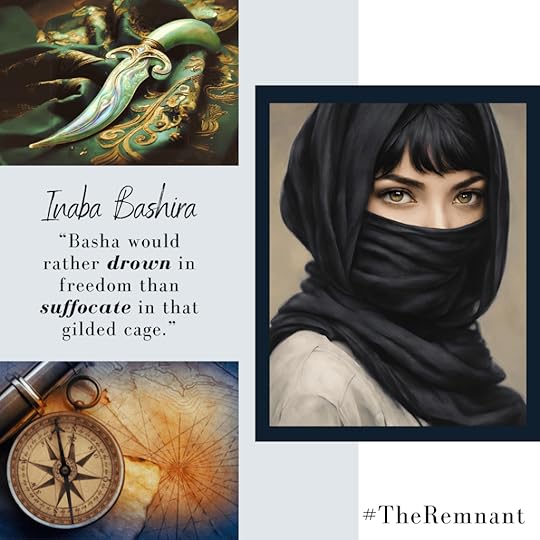 Inaba Bashira (Basha)
Inaba Bashira (Basha) Born: 225 M.E.
Home: Arathet, The Cross-Sea Lands
What’s it like being Signet of Clan Inaba?
Like wearing a pair of boots three sizes too big while trying not to fall on your face in front of an entire room of politicians who already want you to fail. It was never supposed to be me. That was Sara’s role, and she wore it so well. Now, I’m left to fumble my way through her shadow, pretending I have half her grace.
What’s your greatest regret?
That I didn’t go in her place.
What do people misunderstand about you?
They think I don’t care. That I’m lazy. That I’m just some reckless second daughter who doesn’t take any of this seriously. And fine—maybe I did run off to the City Beneath instead of sitting through etiquette lessons. And maybe I did occasionally start tavern fights with smugglers twice my size. But that doesn’t mean I don’t care. I just . . . I don’t know how to care the right way.
If you could trade places with anyone for a day, who would it be?
Someone without a title. Maybe one of the traders who sails between the islands—someone whose only concern is the wind in their sails, not the weight of an entire clan’s future. Someone who can breathe freely without feeling their mother’s expectations press down like an anchor.
Tell me about Chiko.
(Sharp inhale) Chiko. He—he used to be one of the best things in my life. When we were kids, we’d spend hours in the City Beneath, mapping the tunnels, making up stories about what came before. He was always the dreamer, the one who saw the beauty in things no one else did. And then—well. Then everything changed.
If you could rewrite your fate, what would your life look like?
I’d be nobody. No titles, no responsibilities, no expectations weighing down on me like a stone tied to my ankles. Just a girl with a map in her head and the freedom to follow it wherever it led. I’d spend my days exploring the City Beneath, mapping out tunnels no one else dares to enter, making discoveries no Council would ever care about. I’d never have to sit through another three-hour meeting about fisheries or krill populations. And I certainly wouldn’t be stuck in a political marriage with a man who smirks too much.
What’s one thing about Sara no one else knew?
She had this way of making everyone believe she had everything under control, like she was born to lead. And she was. But there were moments—rare, quiet moments—when she let the mask slip. When she was just my sister, when she laughed too loud, when she made up ridiculous songs to help me memorize historical dates. She was human, even if no one else ever saw it. And now she’s gone, and all that’s left is this impossible standard I’m supposed to live up to.
What do you think about Dai?
(Smirks) Oh, him? You mean the walking, talking reminder that my life isn’t mine to control? Look, I’ll give him this—he’s got charm. The kind of charm that makes people forget he’s dangerous. The kind that gets people exactly where he wants them. And I’m not about to be one of those people.
What’s your greatest fear?
That I’ll never be more than just a placeholder. A shadow cast by someone else. A name on a line, a duty bound by ink. That I’ll spend my whole life trying to be something I’m not, only to realize at the end that I never was anything at all.
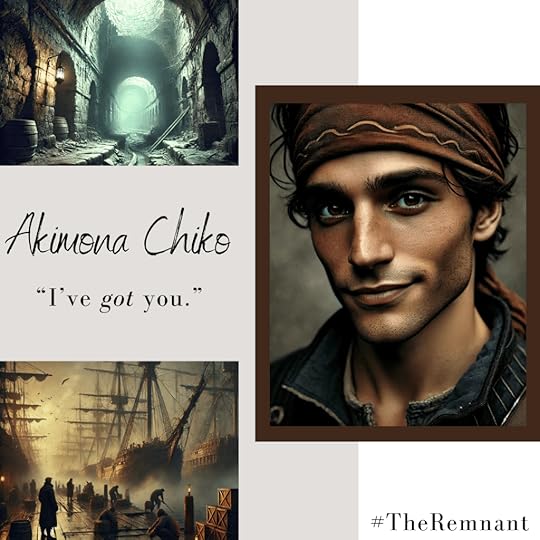 Akimona Chiko
Akimona Chiko Born: 224 M.E.
Home: Arathet, The Cross-Sea Lands
How did you meet Basha?
I don’t remember a time when I didn’t know her. She was always there—louder than she had any right to be, dragging me into trouble I probably would’ve found on my own anyway. We were a team.
What happened between you two?
(Scoffs) She happened. Or maybe I did. Doesn’t matter now.
What’s the hardest lesson you’ve learned?
That people leave. They promise they won’t. They swear on blood and breath that they’ll always be there. And then, one day, you turn around and realize you’re standing alone.
Do you think you’ll ever forgive her?
You don’t forgive someone for surviving while you were left behind. You just learn to live with it.
What do you remember most about Basha from when you were kids?
She always had to be right. Even when she wasn’t. I once spent three hours lost in a collapsed tunnel because she insisted it was a shortcut.
What’s the worst thing someone’s ever said to you?
(Scoffs) Oh, where to begin? “You don’t belong here.” “You’re nothing.” “She never even looked back.” Take your pick.
What would you do if you ever got real power?
(Raises an eyebrow) That’s the thing. No one gives people like me power. We take it.
What do you miss most?
(Quiet) The days when it was just us, running through the tunnels, no titles, no politics, no ghosts. When I still thought she’d always be by my side.
How do you define loyalty?
Loyalty is knowing the shape of someone’s footsteps, the sound of their voice in the dark, the way their laughter used to echo through the tunnels. It’s believing, deep down, that no matter where life takes you, no matter how the tides shift, you’ll always find your way back to each other.
It’s also the most dangerous lie you can ever believe.
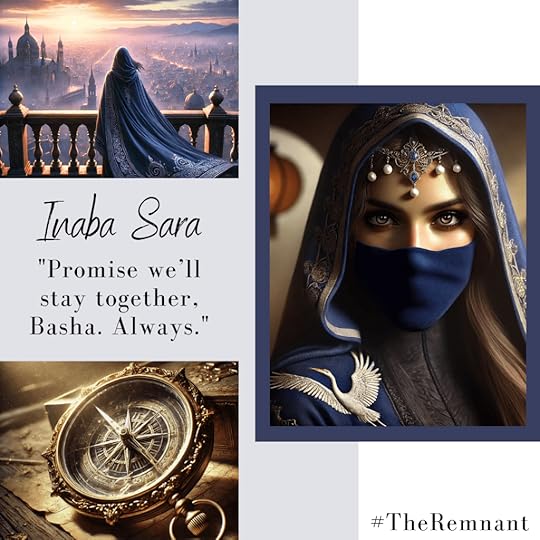 Inaba Sara
Inaba Sara Born: 223 M.E.
Home: Arathet, The Cross-Sea Lands
What does it mean to be Signet?
It means putting your people above yourself. Above your heart, your desires, your own ambitions. It means carrying the weight of centuries and making sure your clan doesn’t crumble under your leadership. It means never hesitating when the moment calls for you to act.
Why did you go to Loren?
(Smiles, but there’s something distant in her eyes)
Because I had to.
What would you say to Basha now if you could?
(Quietly) You were never meant to follow me. You were meant to carve your own path.
What’s the cost of leadership?
Everything.
It means being the first to rise and the last to rest. It means knowing that every decision you make carries the weight of generations before you, that your failures will ripple through generations after. It means swallowing your own wants, your own heart, and turning them into weapons to wield in service of your people.
It means dying before you even get the chance to live.
What is your biggest regret?
I did what needed to be done. But maybe I should have done it differently. Maybe I should have— No. Never mind. It doesn’t change anything.
If you had one more day, how would you spend it?
(Laughs softly) Basha would say I’d spend it in Council chambers, working, planning, scheming. She wouldn’t be wrong.
But maybe, just maybe, I’d steal one last day for myself. I’d take Basha down to the City Beneath, the way we used to when we were young and the world still felt like something we could hold in our hands. I’d let her drag me into trouble. I’d let myself not be the Signet for just a little while.
And then, when the sun set, I’d go back to my duty. Because some things are inescapable, even if you wish they weren’t.
What’s the worst betrayal?
The one you never see coming.
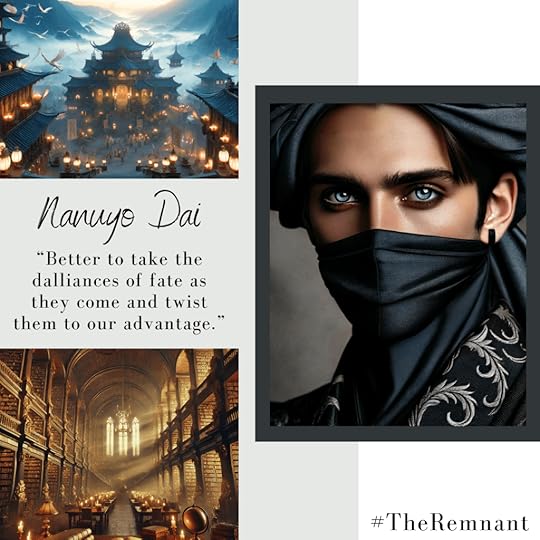 Nanuyo Dai
Nanuyo Dai Born: 222 M.E.
Home: Arathet, The Cross-Sea Lands
How do you feel about being engaged to Basha?
(Grinning) Ah, well. It’s not every day you get tied to the most reluctant bride in the isles, is it? She makes it very clear that she wants nothing to do with me, but what can I say? I do love a challenge.
Do you think she’ll ever change her mind?
She’s stubborn. But so am I. I don’t need her to love me—not yet. I just need her to trust me. And I’m patient.
What do you actually want?
More than just the hand of an Inaba Signet. I want a future for my people. For the Cross-Sea Lands. The world is shifting, and if we don’t claim a place in what comes next, we’ll drown beneath the tide.
What’s your greatest strength?
(Grins) My ability to talk my way out of trouble. Also, my ability to talk my way into trouble.
Be honest—what do you think of Basha?
She’s sharp. Dangerous, if she ever learns how to play the game properly. And as for whether I like her? . . . Let’s just say I enjoy the challenge.
How do you handle being underestimated?
Oh, I love it. Makes everything so much easier. People don’t expect much from a man who smiles too much, who jokes too often, who makes himself the most charming person in the room. And then, when they least expect it, I take exactly what I came for.
And your biggest flaw?
I never stop until I get what I want. (Pauses) Wait, that’s a flaw, right?
What’s your real endgame?
Power. But not just power for myself—power for the Cross-Sea Lands. We’ve spent too long playing the lesser role, too long being seen as the ones who adapt rather than the ones who conquer. I mean to change that.
And Basha? She could be the key to making it happen. If she’s smart. If she listens.
…But she does love making things difficult, doesn’t she?
What’s your biggest regret?
(Laughs) Regret? I try not to collect those. They weigh a man down. And I like to travel light.
I hope you enjoyed this deep dive into the characters of The Remnant! These four are tangled together in ways even they don’t fully understand, and their journey is only just beginning. What’s ahead for Basha as she steps into her sister’s shoes? Will Dai’s ambitions align with her own? And can Chiko and Basha ever recover what was lost?
The Remnant is full of political intrigue, high-stakes choices, and a heroine learning to stand on her own. It’s been one of my favorite stories to write, and I can’t wait for you to meet these characters on the page.
Want more behind-the-scenes details? Drop a comment with the questions you’d like answered!
And if you want even more Legion of Pneumos extras, make sure to check out the rest of the site for maps, lore, and exclusive content.
Until next time, happy reading!
Facebook Twitter Pinterest EmailFebruary 4, 2025
When the World Fights Back: Environmental Collapse in Fantasy Fiction
Fantasy is full of grand conflicts—wars between kingdoms, battles against dark lords, and struggles for forbidden magic. But some of the most compelling fantasy stories explore a different kind of war: the battle between civilization and the environment itself. Whether it’s rising seas swallowing entire cities, relentless storms shaping the fate of nations, or a vengeful Earth striking back against humanity, these tales force characters to confront the consequences of living in an unstable world.
In The Remnant, The Stormlight Archive, The Broken Earth Trilogy, and The Earthsea Cycle, environmental catastrophe isn’t just a backdrop—it’s a force that drives the story forward. Today, we’ll explore how each of these epic fantasies portrays environmental crisis, how their characters respond, and what they reveal about our own world’s uncertain future.
Rising Seas and Climate Collapse The Remnant: The Drowning City
The Remnant: The Drowning City In The Remnant, the people of the Cross-Sea Lands refuse to surrender to the rising ocean. Instead, they build upwards, sealing off old streets and creating new layers of civilization above the flooded ruins. The City Beneath is both a marvel of human ingenuity and a ticking time bomb, as its foundations rot and collapse under the weight of generations.
This is a classic example of humanity’s resistance to environmental reality. Rather than adapting by retreating or changing their way of life, Cross-Sea’s people double down, pushing civilization higher even as it crumbles beneath them. The result? Increasingly deadly sinkholes, a thriving black market in the ruins below, and a society on the brink of catastrophe.
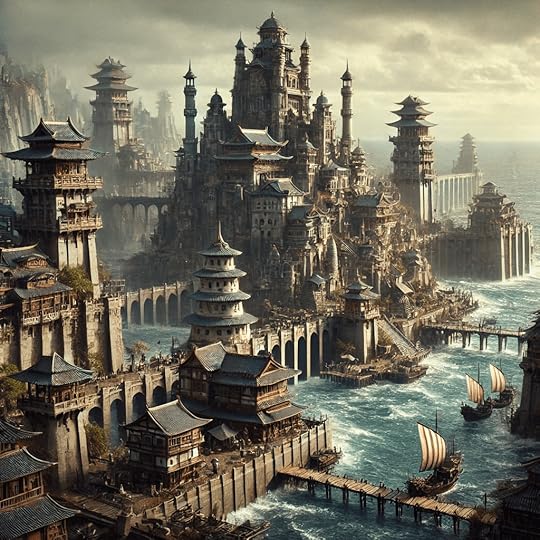

 The Earthsea Cycle: Magic and Environmental Imbalance
The Earthsea Cycle: Magic and Environmental Imbalance While The Remnant presents a world drowning under its own hubris, Ursula K. Le Guin’s Earthsea novels approach environmental collapse through the lens of magical imbalance. In The Farthest Shore, magic itself is disappearing, causing the natural world to wither. Animals vanish, crops fail, and even the ocean grows lifeless. This unraveling isn’t the result of natural disaster but of reckless magic use disrupting the balance of the world.
Where The Remnant mirrors real-world sea-level rise and overdevelopment, Earthsea explores the consequences of exploiting power without understanding its long-term effects—a theme that resonates with modern concerns about resource depletion and climate instability. Both stories force their characters to confront a painful truth: humanity cannot outbuild or outmagic nature forever.
Extreme Weather and Adaptation The Stormlight Archive: A World Shaped by Storms
The Stormlight Archive: A World Shaped by Storms Brandon Sanderson’s The Stormlight Archive presents a world where civilization has been forced to adapt to relentless highstorms. These storms are not rare disasters—they are a constant, powerful force that dictates everything from architecture to warfare. Entire cities are built into cliff sides for protection, and economic systems rely on stormlight-infused gemstones that recharge with each passing tempest.
What makes Roshar fascinating is that its people don’t try to fight the storms. Instead, they’ve built a society that accepts extreme weather as an unavoidable fact of life. This contrasts with The Remnant, where people attempt to resist nature through sheer force of will, and Earthsea, where balance must be restored. The Stormlight Archive shows what happens when civilizations truly integrate environmental challenges into their way of life rather than seeing them as temporary obstacles to overcome.
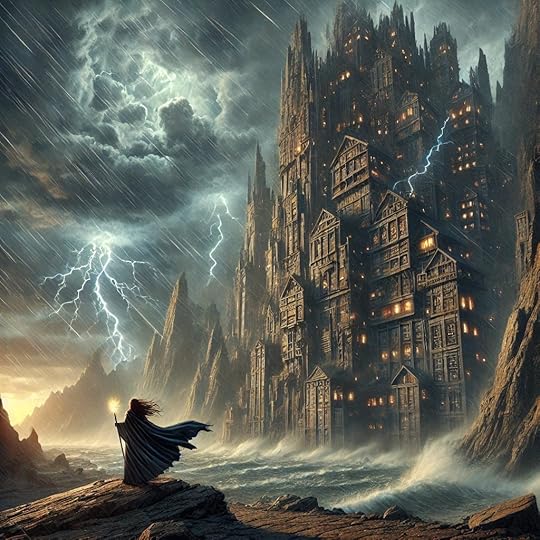
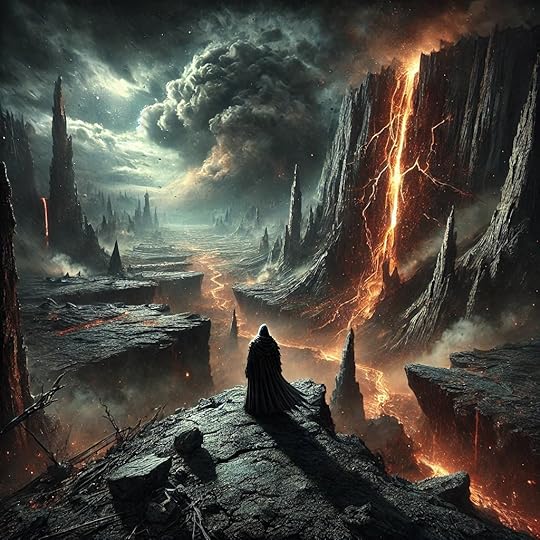
 The Broken Earth Trilogy: The Earth as an Unforgiving Adversary
The Broken Earth Trilogy: The Earth as an Unforgiving Adversary While Rosharans adapt to their environment, the world of The Broken Earth Trilogy actively fights back. In N.K. Jemisin’s apocalyptic setting, earthquakes, volcanic winters, and climate disasters are so frequent and severe that civilization barely survives between devastating events known as “Fifth Seasons.”
The protagonists, particularly the Orogenes—people with the ability to control seismic activity—are both feared and needed. They can prevent earthquakes, but their powers are also seen as dangerous, making them scapegoats when things go wrong. This reflects real-world patterns where those with knowledge of environmental crises (scientists, indigenous communities, activists) are often ignored or even vilified.
Unlike The Stormlight Archive, where adaptation is possible, The Broken Earth Trilogy presents a world where survival is barely achievable. While The Remnant and Earthsea explore the costs of ignoring environmental warnings, The Broken Earth Trilogy suggests that by the time people are willing to change, it may already be too late.
The Environment as an Active Player The Broken Earth Trilogy: A Vengeful Planet
The Broken Earth Trilogy: A Vengeful Planet In Jemisin’s trilogy, the Earth itself is a conscious force. It has suffered abuse from humanity, and it is striking back. This makes the natural world more than just a setting—it becomes a character, an adversary with its own motivations. This is a stark contrast to The Stormlight Archive, where the environment is neutral but dangerous, and The Remnant, where nature’s destruction is a side effect of human arrogance rather than an intentional act.
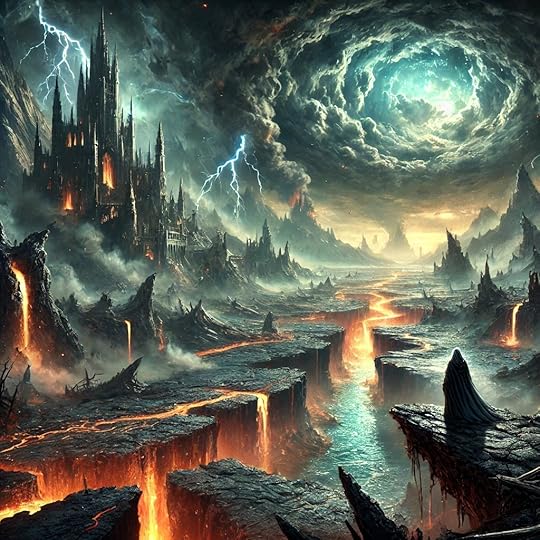

 The Earthsea Cycle: Magic as a Reflection of Natural Order
The Earthsea Cycle: Magic as a Reflection of Natural Order Le Guin’s Earthsea books also portray nature as a living force, but rather than actively seeking vengeance, it exists in a delicate balance. The disappearance of magic in The Farthest Shore causes environmental decay, not because nature is striking back, but because humanity has disrupted the world’s equilibrium. Unlike Jemisin’s apocalyptic setting, Earthsea suggests that balance can be restored if people recognize their mistakes in time.
While The Broken Earth Trilogy presents a grim, almost inevitable path of destruction, Earthsea leaves room for redemption. This contrast mirrors the difference between pessimistic and hopeful perspectives on climate change—are we past the point of no return, or can we still restore what has been broken?
Final thoughts: What Fantasy Teaches Us About Climate ChangeEach of these fantasy narratives presents a different vision of how civilizations respond to environmental catastrophe:
Denial: The Remnant portrays a civilization that refuses to change, even as the foundations crumble.Adaptation: The Stormlight Archive shows a world that learns to live with its extreme climate.Destruction: The Broken Earth Trilogy warns of a future where nature, pushed too far, fights back.Restoration: The Earthsea Cycle suggests that the solution lies in restoring balance rather than dominating nature.These stories resonate because they force us to confront real-world environmental crises through the lens of fantasy. They remind us that nature is not a passive force—it shapes us, and how we respond to it determines our future. Will we be like the people of the Cross-Sea Lands, refusing to change until it’s too late? Can we adapt like Rosharans? Or are we already facing the kind of irreversible catastrophe seen in Jemisin’s world?
Fantasy allows us to explore these questions in powerful ways, making environmental crises personal, immediate, and emotionally resonant.
Join the Conversation!Which fantasy worlds have made you think differently about environmental issues? Do you prefer stories where characters adapt to nature, fight against it, or try to restore balance? Do you think fiction is an effective way to explore climate change? Drop your thoughts in the comments!
And if you want to see how Basha fights to survive in a world crumbling beneath her feet, grab a sneak peek of The Remnant here and sign up for my newsletter for exclusive content!
Facebook Twitter Pinterest EmailJanuary 21, 2025
Exclusive First Look: Cover Reveal for The Remnant
There’s something magical about a book cover—that perfect blend of imagery and intrigue that invites you to step into a world you’ve never known. Today, I am beyond thrilled to reveal the cover for my newest book, The Remnant, a companion novella in the Legion of Pneumos series. With its bold design and intricate details, this cover perfectly encapsulates the heart of the story: the journey of Inaba Bashira, an unlikely heroine rising to meet a destiny she never asked for.
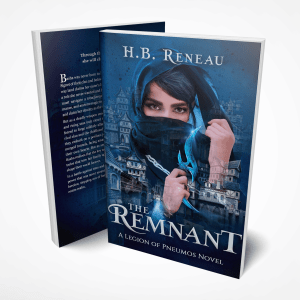 Designing the Cross-Sea Lands
Designing the Cross-Sea Lands Creating the cover for The Remnant was a deeply collaborative and creative process. Natalia Junqueira of Dawn Book Design, the brilliant designer behind the previous Legion of Pneumos covers, returned to bring this vision to life. From the outset, we knew the cover had to reflect the rich and immersive world of the Cross-Sea Lands. This unique setting, with its towering vertical cities built to escape rising sea levels and its network of winding canals, is both breathtaking and precarious—a metaphor for Basha’s own story.
Natalia and I spent hours refining the look of the city. We drew inspiration from a blend of cultures in our own world to to represent the wide diversity of people that escaped the Ravaged Continent as refugees and made the Cross-Sea Lands their home, ultimately crafting a design that captures the verticality and elegance of this sinking island nation. The result is a cover that feels alive, as if the city itself holds secrets waiting to be discovered.
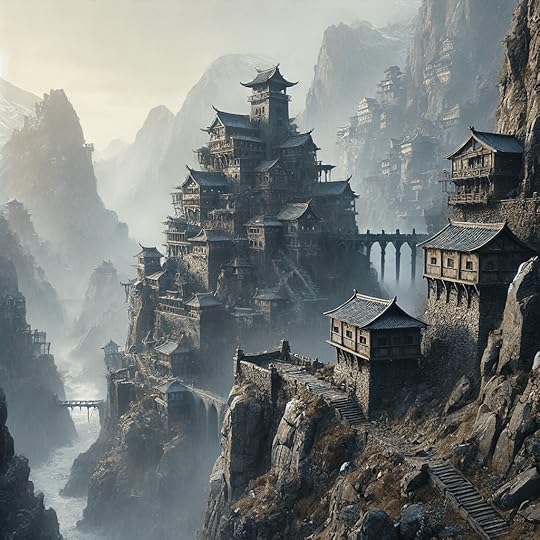

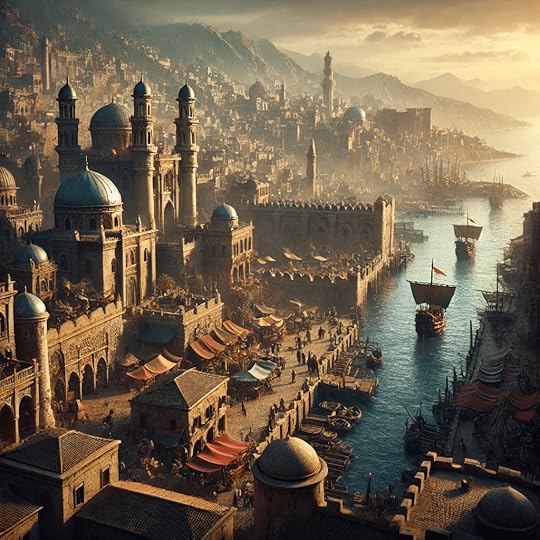 A Heroine in Focus
A Heroine in Focus At the heart of the cover is Inaba Bashira. Natalia’s expert photo manipulation brought Basha to life with a model who embodies her strength and vulnerability. From her intense gaze to the intricate curved dagger in her hand, every element was carefully chosen to reflect the essence of her character. The dagger, a signature weapon forged from the Cross-Sea Lands’ rarest materials, gleams with an iridescent sheen that hints at the ancient magic woven into the story.
We worked meticulously to balance Basha’s poised determination with the softer nuances of her journey. One of the biggest challenges was ensuring her arm and dagger—key elements in the design—stood out against the intricate backdrop without overwhelming the composition. Natalia’s final adjustments, which included lowering the dagger and blending the foreground seamlessly with the background, created a striking and cohesive image that draws the eye to Basha’s captivating presence.

 The Symbolism of Blue
The Symbolism of Blue The color palette of The Remnant plays a vital role in setting the tone for the story. While the other novella covers in the Legion of Pneumos series feature darker hues, this cover embraces a lighter, vibrant blue. It’s a color that evokes the swirling waters of the Cross-Sea Lands while symbolizing hope, mystery, and transformation—all themes central to Basha’s journey.
To achieve this, Natalia used a watercolor splatter texture to add depth and motion to the background, mimicking the flow of water and the turbulence of rising tides. The interplay of light and shadow within the buildings and canals further enhances the sense of a world in constant flux.
 Why This Cover Matters
Why This Cover Matters Every detail on this cover tells a piece of the story. From the ever-ascending buildings to the dagger’s intricate designs, it’s a visual representation of the trials Basha must face: the weight of leadership, the pull of forbidden romance, and the unraveling of ancient secrets that could reshape her world forever.
As a writer, there is nothing more exhilarating than seeing your story take on a tangible form. This cover is more than just a design; it’s an invitation to step into the Cross-Sea Lands and walk alongside Basha as she fights to reclaim her sister’s legacy and forge a path of her own.
The Remnant is a story of resilience, sacrifice, and the unyielding power of hope. It’s for anyone who has ever felt the weight of expectations or the fire of determination to chart their own course. I can’t wait for you to join Basha on her journey.
I’d love to hear your thoughts! What details stand out to you? Do you see yourself wandering through the canals of the Cross-Sea Lands or unearthing the mysteries hidden within its towering cities? Let’s talk about it in the comments below!
Facebook Twitter Pinterest EmailDecember 30, 2024
Behind the Mask: Villains Who Shape the Legion of Pneumos World
What is it about a truly compelling villain that keeps us turning the pages? In the Legion of Pneumos series, the answer lies in the rich complexity of its antagonists. These characters are not merely obstacles to be overcome—they are forces of nature, ideologies given flesh, and mirrors reflecting the heroes’ darkest doubts. Today, we’re peeling back the layers on some pivotal antagonists from the series: the corrupt Bellatorio and its military leaders, the conniving Lady Junia, and the unapologetic rebel leader Neval Brennan. These antagonists and morally ambiguous players shape the story’s tension, making readers question where their own loyalties should lie.
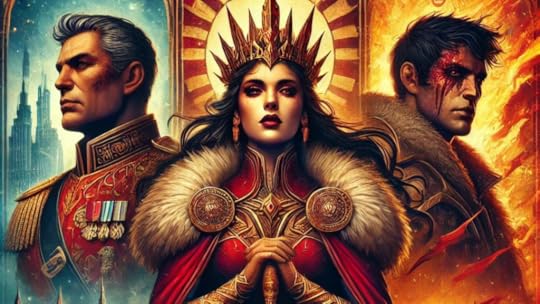 The Bellatori Leaders
The Bellatori Leaders Bellatori leaders Millus Szerio and Imperator Lanus are two sides of the same tarnished coin, each showing a different face of power gone wrong in The Centus. Both men command authority within the Bellatorio, but their approaches to leadership—and their flaws—couldn’t be more different.
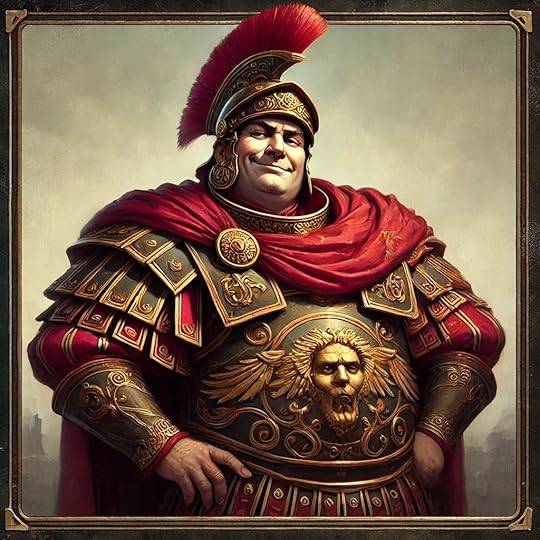
Szerio is the kind of villain you love to hate. He’s brazenly self-serving, brushing off his soldiers’ desperate pleas for help while indulging in the comforts of his rank. His carelessness isn’t just frustrating—it’s dangerous. Yet, beneath his arrogance lies a warped sense of duty. When he orders an act of shocking brutality in the name of the Marian crown, you can see how his blind loyalty has turned him into a tool for a flawed system. He’s not trying to be evil; he’s just too selfish and shortsighted to see the damage he’s causing.
Then there’s Lanus, who, at first glance, couldn’t be more different. He’s polished, strategic, and deeply charismatic—the kind of leader who can make you believe in something bigger. But look closer, and you’ll see the cracks in his armor. His carefully cultivated image as a noble protector hides a ruthless streak, one that whispers of manipulation and betrayal. Unlike Szerio’s brash incompetence, Lanus’s villainy is subtle, creeping in like a shadow until it’s too late to stop him.
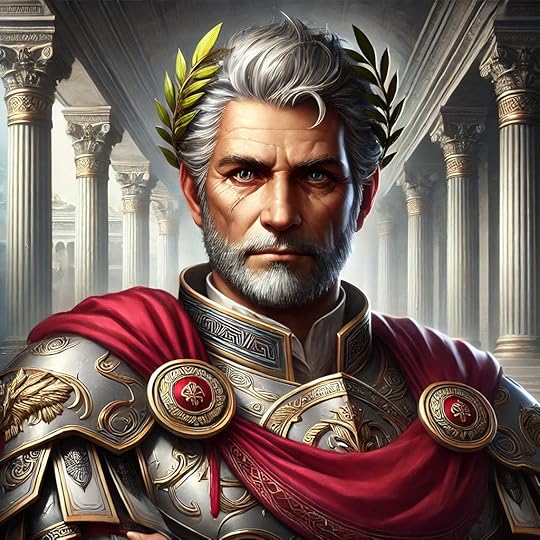
Together, these two men represent the many ways power can corrupt. Szerio’s recklessness and Lanus’s cunning both contribute to the growing sense that something is rotten at the heart of the Bellatorio, and both play pivotal roles in Gaius Flavius’s growing disillusionment. Szerio’s overt failures highlight the immediate, tangible harm caused by poor leadership, while Lanus’s deception and betrayal shatter Gaius’s trust in the very ideals the Bellatorio claims to uphold.
As you delve into The Centus, you’ll find yourself questioning not just the actions of these two villains but the system that created them. Are Szerio and Lanus products of their own flaws, or are they inevitable in a world where power is everything? In this story, villains aren’t just obstacles for the heroes to overcome—they’re reminders of the costs of blind obedience and unchecked ambition. Through them, The Centus explores how power, whether wielded clumsily or shrewdly, can twist even the most steadfast institutions into instruments of destruction.
Lady JuniaLady Junia of Loren is a woman caught between two worlds, and she’s determined to remake both. As the firstborn of the Marian line, she was raised with the values of her ancestors—a culture where men and women stand as equals, where her birthright to rule would have been unquestioned. But in Chaos Looming we learn that Loren, the kingdom her family conquered, doesn’t see her that way. To the people of Loren, leadership belongs to men, and Junia’s claim to the throne is dismissed, not because she lacks the skills, but because of her gender.
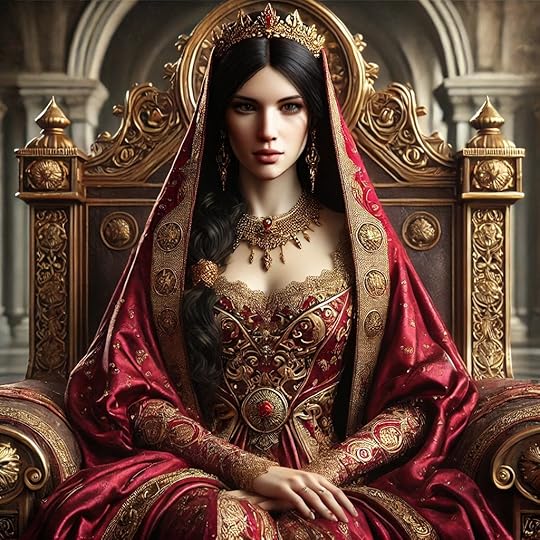
To outsiders, she’s poised, commanding, and utterly unshakable. But behind her calculating gaze lies a storm of ambition and a wound that has never truly healed: the sting of being overlooked, underestimated, and denied what she believes is her rightful place. This rejection is a wound that fuels her relentless ambition. To Junia, the people of Loren are the ones who are backward, clinging to outdated traditions that deny her rightful place as Regio. Every manipulative move she makes, every cold-hearted decision, is justified in her mind by this injustice. She sees herself as a pioneer, fighting not just for her throne, but for the recognition of her worth as a leader—and for the countless women after her who will face the same barriers.
But ambition has its price and Junia’s crusade is anything but noble. Her tactics are ruthless, her vision singular. While her pain is real and her desire for equality understandable, her methods force us to ask whether the ends justify the means. She uses her brother Landry as both a pawn and a rival, believing his softer nature proves his unfitness to rule. And in her eyes, the people of Loren are obstacles to be overcome, not subjects to be protected. Junia’s fear of being perceived as weak or unfit drives her to relentless extremes. She tells herself that her actions are for the good of the kingdom, but deep down, her ruthless pursuit of power is as much about proving her own strength as it is about ruling wisely.

This tension makes Junia one of the most complex figures in Chaos Looming. Raised in the Marian tradition, she carries the ideals of equality and progress. But in her pursuit of power, she becomes a mirror of the very empire we’re taught to despise. Is she a villain born of circumstance, or a revolutionary whose tactics went too far? As you read, you may find yourself grappling with the same question—and realizing that the answer isn’t as simple as it seems.
Neval BrennanNeval Brennan is the kind of character who turns the idea of heroes and villains on its head, leaving you to sift through the shades of gray. In Chaos Looming, he’s introduced as a rebel leader stirring up chaos in Loren, a thorn in the side of both the Marian Empire and the Legion of Pneumos. But as his story unfolds, the line between rebellion and righteousness blurs, leaving readers to wonder: is Neval a villain, or just a hero fighting for the wrong side—or in the wrong way?
Charismatic and relentless, Neval inspires fierce loyalty from the uplanders he leads. To them, he’s a champion of justice, fighting against the Marian Empire’s exploitation and the systemic neglect that has left their lands in ruin. His rebellion is born from a lifetime of witnessing suffering—the kind that burns itself into your soul and demands action. But action has a cost, and Neval’s choices often leave blood in their wake. His barricades and riots disrupt lives, and his unwillingness to compromise puts him at odds with those who seek a more peaceful resolution.
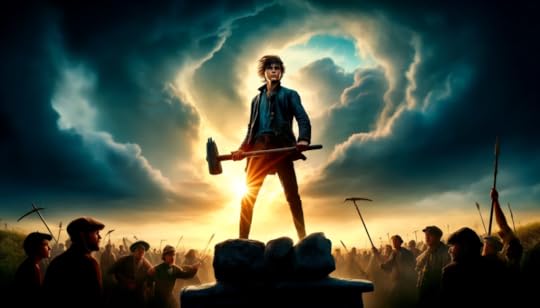
What makes Neval truly compelling, though, is the nuance in his motivations. Beneath his hardened exterior lies a man shaped by personal loss and societal scorn. He’s not fighting just to overthrow the Empire—he’s fighting to prove that his people deserve more than the scraps they’ve been given. Yet his methods, often ruthless and manipulative, force us to confront uncomfortable truths about the cost of justice.
In The Rebel, we see the roots of his defiance: a childhood of poverty, a tragic loss to the Empire’s brutality, and a lifetime of being told he was powerless. These experiences fuel his fire, but they also weigh on him, adding layers of guilt and sorrow to his quest for change. It’s this blend of vulnerability and determination that makes Neval more than a standard rebel leader. He’s a man caught between the world as it is and the world as he dreams it could be, and that tension makes every choice he makes—heroic or horrific—all the more gripping.

And Neval’s story doesn’t end with Chaos Looming—far from it. In Haven Enduring, his motivations grow even more tangled, his actions more calculated. As he steps deeper into the shadows, Neval begins to weave a web of alliances and deceptions that blur the lines between hero and manipulator. With every choice, he forces those around him—and readers—to question whether his vision of justice is worth the price he’s willing to pay. As you delve into his story, you’ll find yourself asking not just what makes a villain, but what makes a cause worth fighting for. Does the end truly justify the means? Or is Neval’s vision of justice destined to crumble under the weight of his own compromises?
The world of Legion of Pneumos is shaped as much by its villains as its heroes, and nowhere is this more evident than in the ruthless authority of the Bellatorio, the relentless ambition of Lady Junia, and the fiery rebellion of Neval Brennan. Each of these figures pushes the boundaries of morality, forcing readers to confront uncomfortable truths about power, justice, and sacrifice. From the calculated manipulations of Junia to the raw defiance of Neval, and the flawed yet potent authority of the Bellatorio, these antagonists are not mere obstacles—they are the lifeblood of a world teetering between order and chaos. As their stories unfold, they challenge us to question not just what it means to be a villain, but what it takes to rise above the forces that seek to define us. Their legacies leave an indelible mark on Loren, and on anyone brave enough to step into their shadowed, tumultuous world.
Facebook Twitter Pinterest EmailDecember 4, 2024
Magic Systems That Matter: Fueling Character Transformation
Magic in a story is most powerful when it reflects the growth and struggles of the characters who wield it. In my Legion of Pneumos series, the core of worldbuilding—pneumonancy—does more than establish fantastical rules; it mirrors and amplifies the personal journeys of characters, particularly Keira. Her fatal flaw, an unwillingness to trust others, is highlighted by a magic system that ironically necessitates collaboration. This thematic twist enriches the narrative and provides readers with an emotionally resonant experience.
For more background on my approach to worldbuilding and magic systems, check out Part 1 at Magic Systems That Matter: From Core Idea to Thematic Resonance.
Table of Contents Magic and Character Arcs: A Reflective DanceWorldbuilding and character development should feel symbiotic, where one informs and enhances the other. In The Legion of Pneumos, Keira’s arc is deeply entwined with the practice of pneumonancy. Her raw power as a cantor—a type of pneumonancer with far-reaching capabilities—requires grounding to be safe and effective. This introduces an ironic struggle: Keira, fiercely independent and wary of vulnerability, must learn to depend on others, specifically her grounder, to wield her full power.
This aspect of the magic system is more than just a rule; it’s a narrative tool that underscores her personal evolution. As Keira grapples with her reluctance to rely on Danny, her grounder, the tension between her desire for control and the necessity of partnership drives her growth. This dynamic not only deepens her character but enriches the story’s theme of finding strength through connection—a poignant parallel to the series’ backdrop of civil discord, where unity is needed to combat chaos.
This dynamic is also seen in other pieces of fantasy literature. In by Patrick Rothfuss, Kvothe’s mastery of sympathy—a magic based on scientific principles—mirrors his relentless quest for control over his chaotic life. His struggles to balance emotion and logic in his use of magic highlight his broader journey of self-discovery. Sympathy becomes more than a tool; it is a reflection of his internal conflicts and ambition.
Similarly, in A Wizard of Earthsea by Ursula K. Le Guin, Ged’s magic, based on true names and balance, mirrors his personal journey to understand himself. Early in the story, his reckless use of magic unleashes a shadow that symbolizes his darker nature. His journey to master magic parallels his journey to confront and integrate his flaws, blending character growth with worldbuilding seamlessly.
Questions for Writers:
What character traits or flaws do I want to highlight in my protagonist?How can the magic system in my world create challenges that reflect these traits?What ironic or unexpected dependencies can arise between characters and their use of magic?How does the magic’s function push my character toward personal growth or self-realizatio Limitations as Mirrors of Inner Conflict
Limitations as Mirrors of Inner ConflictA well-crafted magic system should have inherent limitations that tie into the protagonist’s internal battles. For Keira, the risks of ungrounded pneumonancy—being undone and left as an empty shell—are a metaphor for her fear of losing control and autonomy. This dire consequence makes her reliance on Danny not just a physical necessity but an emotional hurdle. Every time she hesitates to accept his help, she’s risking more than just failure; she’s flirting with personal dissolution.
These stakes make her choices resonate on a deeper level, where the outcome is not just about mastering her powers but confronting the vulnerabilities she’s tried to deny. Pneumonancy’s constraints turn each encounter into an opportunity for character reflection, making magic a catalyst for emotional stakes.
Another example is The Fifth Season by N.K. Jemisin. In this story, Essun’s use of orogeny carries the risk of catastrophic destruction if not carefully controlled. This limitation mirrors her internal struggle with anger and grief, forcing her to confront her emotions and find balance to avoid devastating consequences.
Questions for Writers:
What limitations exist in my magic system, and how do they reflect my character’s inner fears or desires?How do these limitations force my protagonist to confront their flaws?What are the real, personal consequences for failing to navigate these limitations?How can my character’s growth be measured by their changing relationship with the magic system’s boundaries? Thematic Harmony: Magic and the World
Thematic Harmony: Magic and the WorldIn The Legion of Pneumos, the broader theme of entropy and the gradual descent into chaos is both reflected in the civil war threatening the kingdom and echoed in Keira’s internal battle. Pneumonancy, with its core rooted in maintaining a balance between chaos and order, becomes a mirror for the protagonist’s struggle to find equilibrium between isolation and trust.
Keira’s journey emphasizes that true mastery of power comes not through force or isolation but through understanding and cooperation. The idea that she must harmonize her chaotic energy with another’s stabilizing presence reflects the wider societal need for unity amid division. This thematic overlap strengthens the narrative’s cohesion, allowing readers to see how personal and collective struggles mirror each other.
Similarly, in The Lord of the Rings, by J.R.R. Tolkien, the One Ring symbolizes the corrupting influence of power on both individuals and the society as a whole. It ties the story’s magic system to its broader themes of temptation, sacrifice, and the triumph of collective effort over individual greed. The magic system enhances the narrative’s moral complexity and universal resonance through its impacts on both the world and the lives of individual characters.
Questions for Writers:
What themes do I want to explore, and how can my magic system underscore them?How do my protagonist’s personal challenges echo the larger issues within the story’s world?Can my magic system’s mechanics serve as metaphors for broader themes?How can the resolution of the protagonist’s arc also signal a shift in the world’s state of balance?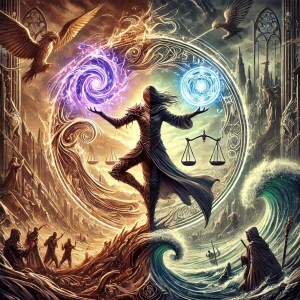 Irony and Growth: The Unexpected Paths of Trust
Irony and Growth: The Unexpected Paths of TrustPerhaps the most compelling aspect of a magic system that reflects character growth is when it incorporates irony. For Keira, the ultimate irony is that while she believes strength comes from independence, her true power lies in partnership. This becomes a poignant lesson as the series progresses. The more she resists trusting Danny, the more perilous her attempts at powerful binds become. Yet, as she learns to share the burden and work in tandem, her growth as a person becomes palpable.
Another example of this is in the Mistborn series by Brandon Sanderson. In the first book, Vin begins her journey believing she must protect herself by trusting no one. The irony lies in her realization that her Allomantic powers are amplified when she fights alongside her crew, and her bond with Elend strengthens her both emotionally and magically.
In both these stories, the magic system is not just a backdrop to the action but a critical player in character development. It creates situations where Keira and Vin must choose between the safety of their emotional walls and the risky path of vulnerability. Choices like these make a character’s victories hard-earned and deeply satisfying, as they reflect a broader shift from isolation to solidarity.
Questions for Writers:
What assumptions does my protagonist hold that can be challenged through their use of magic?How can I create an ironic twist that forces my character to re-evaluate their beliefs?What lessons does my character learn from the way they engage with the magic system?How can their growth be shown through changes in how they use their magical abilities?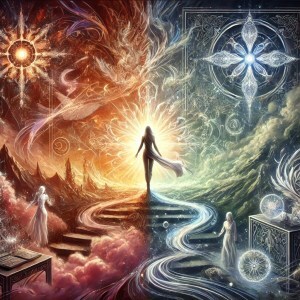 Final Thoughts: The Dance Between Power and Self-Discovery
Final Thoughts: The Dance Between Power and Self-DiscoveryIn a well-developed fantasy world, the magic system does more than solve problems or add spectacle—it serves as a crucible for transformation. In The Legion of Pneumos, Keira’s growth from self-reliant and distrustful to someone who finds strength in connection is mirrored perfectly by the demands and nuances of pneumonancy. As writers, harnessing this reflective dance between magic and character arc can turn a good story into an unforgettable journey.
Final Reflection Questions for Writers:
Does my magic system encourage character development, or is it purely functional?How does the protagonist’s relationship with magic evolve over the course of the story?In what ways can the magic system make the protagonist’s growth essential to their success?How do the lessons learned through magic tie into the final resolution of the story’s main conflict?Magic is the most powerful when it creates a sense of resonance with a character’s arc, forcing them to confront their past wounds and invoking costs that force characters to face their deepest fears.
Lean into that.
Let your magic not just dazzle but deepen, and your characters’ journeys will resonate that much more.
Also, I’d love to know: What’s your favorite fictional magic system and why? Hit “reply” and share your thoughts—I’m always looking for new inspiration!
Facebook Twitter Pinterest EmailNovember 4, 2024
Magic Systems That Matter: From Core Idea to Thematic Resonance
Whether it’s the languages of Middle Earth or the warring factions of Westeros, worldbuilding is perhaps one of the most beloved components of the fantasy genre. Yet it is perhaps magic systems that cause writers and readers alike the most consternation. Building a magic system that resonates with your character’s arc, your story’s themes and the broader facets of the world is both art and science. I’m excited to share some of the tips and tricks I’ve learned along the way.
This will be a two part series. This month we’ll cover the basics of magic systems, their core ideas, limitations, and how they interact with broader story themes. Next month we’ll dive deep into how magic systems interact with character arc and development so check back soon!
Table of Contents The Seed Crystal ConceptWhen crafting The Legion of Pneumos, the initial spark was pneuma—a subtle, omnipresent energy connecting all things. Pneuma acts as the breath of life itself and yet is fueled by entropy, the tendency of all systems to trend toward disorder. I believe many magic systems start this way, as a spark of an idea, often without weight or bounds. C.R. Rowenson describes this as a seed crystal, the foundation from which a magic system can grow. In my series, pneuma served as the series’ core concept, from which every magical principle sprouted. Pneuma’s chaotic nature symbolized the perpetual dance between chaos and order, and was a fun nod to my background in medicine and love of science.
In the series, pneuma is harnessed through sound—usually whistles—requiring the wielder to match their energy’s frequency to their target’s. This detail, while grounded in scientific ideas of resonance and wave mechanics, adds an almost mystical layer to the magic. The fundamental idea that even chaos can be directed, though not controlled, became a central theme mirrored in Loren’s tumultuous political landscape.
Takeaway for Writers: Identify an intriguing, foundational concept for your magic and explore how it could manifest in various aspects of your world.
Questions to ask:
What fundamental concept can anchor my magic system and echo my story’s themes?How can this concept be visualized or embodied in the world’s rules?What real-world influences (e.g., scientific principles, cultural beliefs) can enrich the magic’s development? Hard vs. Soft Magic
Hard vs. Soft Magic Brandon Sanderson’s division of hard and soft magic systems provides a useful lens through which to understand magic systems. The idea is that the clearly defined rules of hard magic systems allow for problem-solving within the story, while undefined aspects of soft systems maintain a sense of awe and wonder. C.R Rowenson expands on his idea and places these concepts on a dual axis spectrum while using elements like transference and reliability to adjust how predictable or enigmatic their magic appears
For example, in Patrick Rothfuss’s The Kingkiller Chronicles, his magic system based on naming and sympathy is both rational and mysterious, offering a blend of hard and soft magic. The system’s depth ties closely to the protagonist’s quest for knowledge and power, resonating with the story’s themes of ambition and loss.
In Legion of Pneumos, the mechanics of pneuma manipulation include hard, well-defined rules: cantors must resonate their pneuma to specific frequencies, while grounders anchor and stabilize magical effects. This framework clarifies what pneumonancers can achieve and what risks they face, like being “undone”—a fate where they lose their sense of self and their bodies become husk-like.
Yet, not all is defined. The world contains mysteries, such as Keira’s discovery of healing pneumonancy. This unexpected power adds a touch of soft magic, enhancing the series’ sense of wonder. It’s a delicate balance: too rigid a system would strip away the story’s intrigue, while too flexible a system risks diminishing stakes
Takeaway for Writers: When crafting magic systems, use detailed mechanics for problem-solving and strategic moments, and reserve more nebulous aspects for creating suspense and thematic weight.
Questions for Writers:
Do I need my magic system to solve problems (hard) or evoke awe (soft)?Which rules should I establish clearly, and where can I allow for ambiguity?How can the magic’s rules (or lack thereof) influence plot twists and character development?How does the balance between structure and enigma support my story’s suspense and pacing?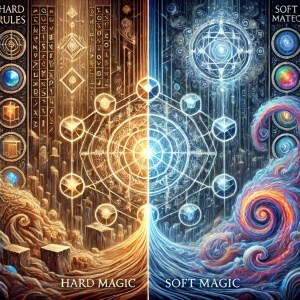 Embracing Limitations
Embracing Limitations Crafting a compelling magic system is not just about power and grandeur but about defining its boundaries. These limitations are the silent drivers that make magic systems interesting, balanced, and resonant. They contribute to character growth, enhance narrative tension, and echo thematic elements. There’s a reason Brandon Sanderson’s second law of magic is that limitations are more important than powers. Without limitations there can be no stakes.
Whether based in resource restrictions, physical or mental costs, skill and mastery requirements, moral and ethical concerns, dependency on external factors, or the potential for backfires or loss of control, magical limitations are important vehicles for character development, plot progression, and thematic resonance.
In The Legion of Pneumos, Pneumonancy’s greatest strength lies in its inherent risks and restrictions. While cantors possess a far-reaching and potent pneuma, capable of manipulating objects and people from a distance, grounders have a pneuma that is intrinsically tied to their physical body and the earth, making them adept at anchoring themselves and providing stability during pneumonancy.
Without a grounder’s stabilizing influence, cantors risk being unmoored, resulting in dissociation or death. This limitation introduces an un important source of conflict and dependence between characters. Furthermore, pneumonancers of all types can overextend their pneuma, leading to physical and mental collapse, reinforcing the need for strategy and restraint during conflict.
These boundaries create narrative tension and mirror real-world challenges of managing power and responsibility. For Keira, mastering her abilities means understanding these risks intimately, embodying the struggle of imposing order on chaos—a metaphor for the civil war threatening to unravel Loren.
Takeaway for Writers: Ensure your magic system has meaningful costs. These limitations should not only serve as plot devices but reflect larger themes or character journeys to add resonance and depth to your story.
Questions for Writers:
What are the specific costs or dangers associated with my magic system?How do these limitations push characters into uncomfortable growth?What metaphors do these limitations offer for the story’s larger themes?What tangible or intangible costs can I introduce to reinforce these themes?Are there situations where magic could fail or backfire, adding to the tension?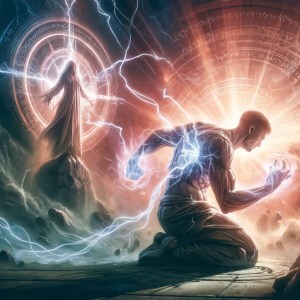 Magic as a Thematic Mirror
Magic as a Thematic Mirror Magic in fantasy stories is more than just a tool or a plot device—it’s an essential element that can mirror and amplify the central themes of a narrative. When well-integrated, it becomes a profound storytelling mechanism that deepens the story’s impact on readers.
In The Earthsea Cycle, Le Guin’s magic system is deeply tied to the theme of balance and true names, reflecting Taoist philosophy. Her exploration of power’s cost and the consequences of imbalance can serve as a model for thematic mirroring in magic systems.
In The Legion of Pneumos, magic isn’t just a tool; it’s a narrative mirror reflecting societal and personal conflicts. Pneumonancy’s central theme—order versus chaos—is woven throughout the series. The Legion itself symbolizes a bulwark against chaos, an institution fighting the inevitable decline mirrored in the civil unrest fracturing the kingdom–even when their methods seem questionable.
Keira’s journey embodies this conflict. Torn between controlling her power and embracing its chaotic nature, she reflects the series’ larger questions: Can true order ever be sustained? What sacrifices are justified to maintain it? These dilemmas play out through the magic’s consequences, where every act of binding pneuma tightens the tension between security and freedom.
Takeaway for Writers: Use your magic system as an extension of your story’s themes. When characters struggle with its use, they should also wrestle with the story’s deeper moral and philosophical questions.
Tips for Integrating Magic with Theme Effectively
Define the Thematic Core Early: When planning your story, decide on the core themes you wish to explore. Is your story about the balance between freedom and control, the pursuit of knowledge, or the cost of ambition? Make sure the magic system supports these themes. In by Patrick Rothfuss, the pursuit of naming magic reflects Kvothe’s search for identity and truth, creating a resonance between the magic and his overarching quest.
Use Symbolism: Incorporate symbolic aspects into the magic system to subtly reinforce themes. In The Earthsea Cycle, Ged’s shadow represents the darker aspects of himself, which he must confront and understand to achieve balance. The magic system’s insistence on true names symbolizes the theme of knowing and embracing one’s true nature.
Create Costs that Reflect Theme: Ensure that the limitations and costs of using magic align with the thematic message. For example, if a story’s theme is the dangers of ambition, the magic might require a personal sacrifice that leaves the user changed or diminished each time it is used. Sanderson’s Mistborn series incorporates this by using metals as fuel, creating a physical resource limitation that reflects themes of power’s finite nature and the consequences of overreaching.
Show Progress Through Magic: As the protagonist evolves, their relationship with magic should change to reflect their growth. In The Cantor and Chaos Looming, Keira’s initial mistrust of relying on her grounder contrasts with her eventual understanding that true strength comes from unity. This progression aligns with the story’s larger theme of interdependence versus isolation.
Questions for Writers:
How does my magic system reflect the main themes of my story?Are there key moments where magic use parallels a character’s internal conflict?Does a character’s relationship with magic symbolize their personal growth or highlight their struggles?Can conflicts around magic reflect larger social or ethical issues in my story’s world?Are there symbolic elements in the magic that reinforce the story’s message?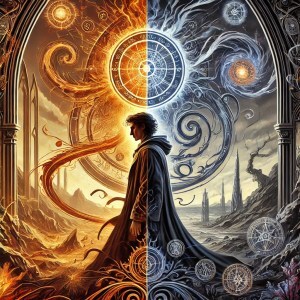
Creating a magic system is as much about constraints as possibilities. With pneumonancy, I aimed to craft something that wasn’t just visually captivating but deeply tied to the narrative fabric of The Legion of Pneumos. Whether through C.R. Rowenson’s idea of seed crystals or Sanderson’s hard/soft magic principles, each aspect of your system should resonate with the story you’re telling. For me, that meant exploring chaos and control, both within characters and in the crumbling world they seek to protect.
Final Reflection Questions for Writers:
How does my magic system serve more than a functional purpose?In what ways does the magic contribute to the emotional and thematic arcs of my story?How does the protagonist’s mastery (or failure) of the magic signify broader narrative themes?When crafted with intention, magic transforms from an entertaining gimmick to an integral thread in the fabric of your world, enriching both plot and character in meaningful ways.
So, what story will your magic tell? Share your thoughts below! And check back next month for Part 2 of the series, Magic Systems that Matter: Fueling Character Transformation.
Facebook Twitter Pinterest EmailOctober 4, 2024
From Strategists to Protectors: Exploring Leadership Styles in Fantasy
One of the things I love most about writing fantasy is how it allows us to explore big ideas—ideas that can shape not only the characters in the story but also how we think about ourselves. Leadership is one of those universal themes that keeps popping up in my stories, whether I intend for it to or not. And honestly, I think that’s because leadership, in all its forms, is something we can relate to in our own lives.
In the Legion of Pneumos world, leadership takes many forms. Some characters lead through compassion, others through strategic thinking or sheer force of will. As The Remnant approaches its release, I’ve found myself reflecting on how three central characters—Neval, Basha, and Keira—embody different aspects of leadership. Each of them starts their journey with distinct leadership styles, and as the story unfolds, we see how those styles evolve based on the challenges they face.
Let’s dive into how leadership plays a role in their lives, and what we can learn from them along the way.
Neval: The Reluctant Leader
Neval, the fledgling leader in The Rebel, has a leadership story born of necessity. His story begins in a place familiar to many of us—he’s a reluctant leader, thrust into a position of responsibility not because he sought it, but because it’s been placed upon him. He’s compassionate and deeply empathetic, which are strengths in their own right. But in a world where every decision can have far-reaching consequences, his desire to protect everyone around him sometimes makes leadership difficult.
Neval’s biggest struggle as a leader is finding the balance between his natural empathy and the hard decisions that leadership often demands. When lives are at stake, he can’t always afford to listen to his heart—but he also can’t lead without it. Throughout The Rebel and the broader Legion of Pneumos series, we see Neval grow into a leader who understands that vulnerability and strength aren’t mutually exclusive. He learns that by showing his humanity, he can inspire loyalty and trust in those who follow him.
It’s a leadership style that feels particularly relevant today, where empathy and emotional intelligence are often key to making meaningful connections and leading effectively. Neval’s journey reminds us that being a leader isn’t about having all the answers—sometimes, it’s about having the courage to admit when you don’t.
Keira: The ProtectorKeira, the protagonist of The Cantor, Chaos Looming, and Haven Enduring, embodies a different kind of leadership altogether—one rooted in protection and loyalty. Her leadership style is defined by her fierce dedication to those she loves and the lengths she’s willing to go to keep them safe. For Keira, leadership is about sacrifice. She sees herself as the shield for her people, always putting their needs above her own. But this selflessness also becomes her biggest challenge.
Keira’s journey is about learning that leadership doesn’t have to mean bearing the burden alone. As much as she wants to protect everyone, she eventually realizes that true leadership is about empowering others to protect themselves. By trying to carry everything on her own shoulders, she risks alienating the very people she’s trying to help. Her arc is one of realizing that leadership isn’t just about fighting battles for others—it’s about helping them find the strength to fight alongside you.
Keira’s leadership reminds us that being a protector is noble, but it can also be isolating. Leaders who are too focused on shielding others often forget that they, too, need support. Keira’s evolution as a leader teaches us the value of trust and collaboration in leadership—sometimes, the greatest strength comes from standing together, not apart.
 Basha: The Strategist
Basha: The Strategist 
If Neval leads with his heart, Basha leads with her mind. Protagonist of the upcoming novella, The Remnant, she’s the quintessential strategist, always thinking several steps ahead, calculating risks, and devising plans to keep her people safe. Basha is a warrior by training, and her leadership style reflects that discipline. She thrives on precision, logic, and the ability to make tough decisions quickly. But her journey is about realizing that leadership isn’t just about strategy—it’s about understanding the human element behind those decisions.
At the start of her story, Basha sees leadership as a means of control—a way to keep things moving in the right direction, to steer the ship, so to speak. But as she interacts with her companions and faces challenges that force her to reconsider what leadership really means, she starts to understand that true leadership is as much about listening as it is about planning. Her arc is one of transformation, where she learns to trust her instincts, but also to trust the people around her.
Leaders like Basha remind us of the importance of adaptability. No matter how well-thought-out a plan is, real leadership requires being able to pivot when things don’t go as expected. Basha’s story teaches us that while strategy and precision are crucial, leading with understanding and flexibility can make all the difference.
What I love about these three characters—Neval, Basha, and Keira—is how different their leadership styles are, yet how similar their goals remain. Each of them wants to protect and guide their people, but the way they go about it couldn’t be more different. Neval leads with empathy, Basha with strategy, and Keira with sheer willpower. And yet, as their stories progress, we see how their leadership styles begin to converge, borrowing from each other as they face new challenges.
Leadership, whether in fantasy or the real world, is never one-size-fits-all. Some lead with their heart, others with their mind, and still others with their strength. What matters most is how these qualities evolve and adapt to the needs of the moment—and how leaders are willing to grow alongside their people.
Whether you see yourself in Neval’s compassionate leadership, Basha’s tactical brilliance, or Keira’s fierce protectiveness, there’s something to learn from each of these characters. The beauty of leadership in fantasy is that it allows us to explore the different ways we can lead in our own lives—whether that’s in our families, our communities, or even just in how we lead ourselves through tough times.
I’d love to hear your thoughts on leadership in fantasy! Who are some of your favorite leaders in fiction, and what makes them stand out to you? Feel free to share your thoughts in the comments or shoot me a message—I always love hearing from you. 
Until next time, keep leading with heart, mind, and courage. 

August 27, 2024
The Remnant: Reading Soundtrack
In the meantime, you can pre-order the book here!
August 6, 2024
The Rebel: Reader’s Guide
Hey there, fellow rebels and dreamers! Welcome to the lastest installment of our Reader’s Guide series featuring . . . The Rebel!
Today, we’re diving headfirst into the gritty, heart-wrenching world of The Rebel, the latest novella in the Legion of Pneumos series. This is a story that will sink its claws into you and not let go, a tale of love, loss, and the searing pain of fighting for a better world. So buckle up, because we’re about to unpack all the juicy details that make The Rebel such a compelling read.
Whether you use it to dive deeper yourself, chat with friends, or host your own book club, I hope this Reader’s Guide helps you get the most out of The Rebel and the rest of the Legion of Pneumos series. Whether you’re a fantasy veteran or new to the genre, there’s something here for everyone!
Discussion Questions Characters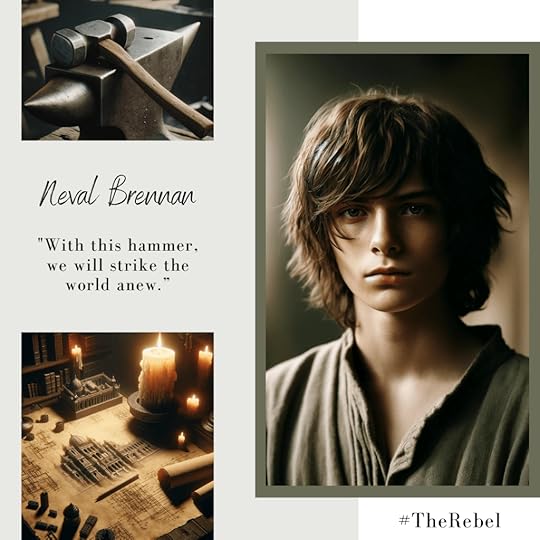
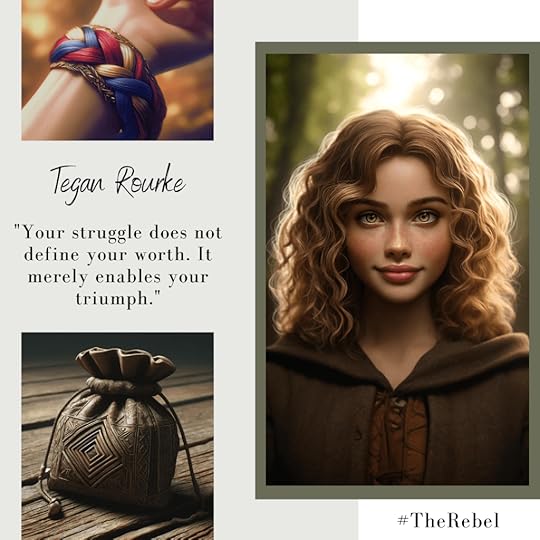
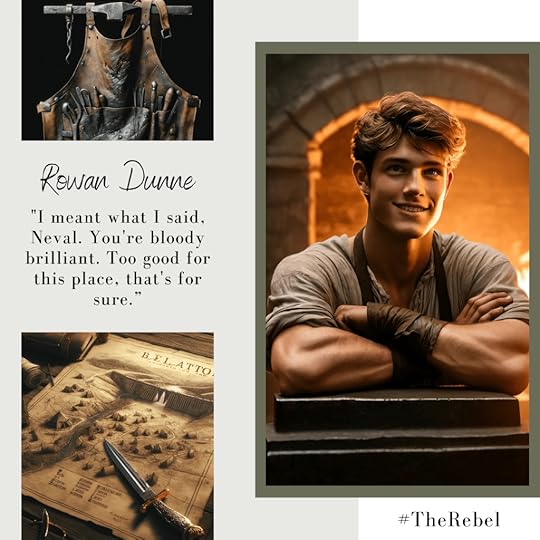
Analyze Neval’s character development over the course of the novella. How does his background as the son of the town drunk and an outcast shape his choices and relationships? In what ways does he change?
Compare and contrast Tegan and Rowan. What qualities attract Neval to each of them? How do their differing social positions and expectations shape their actions and ultimate fates?
Discuss the complicated dynamic between Neval, Tegan, and Rowan. How does the love triangle impact and get impacted by the larger events of the story? Do you think the characters make the right choices?
Examine the father figures in Neval’s life, especially his own father Erik and the Empire’s Millus Flavius. How do they influence Neval’s view of himself, his place in the world, and the man he wants to become?
Want to explore more? Meet the Cast PlotAt its core, The Rebel is a story about fighting back against oppression, even when the odds seem insurmountable. While the inciting incident sets the stage for a tale of resistance and sacrifice, its the escalating trials and heartbreak that forge Neval into something new, harder and sharper. And then, the final blow–the sacrifice at the story’s climax is a moment that will leave you gasping. It’s a turning point that asks us to consider the cost of rebellion, the price of freedom. Is it worth it? That’s a question you’ll have to answer for yourself.
The inciting incident of the story is Neval killing a Bellator soldier to protect Tegan. How does this act set the tone and stakes for the rest of the novella? Does Neval’s character arc justify or complicate this early choice?The Bellators’ construction of the Karthaíla Dam and threatened flooding of Neval’s village is the main external conflict. How does this colonizing force create the conditions for rebellion? Do you think destroying the dam was the right thing to do?Neval faces setbacks including his fight with Rowan, his father’s arrest, and Tegan’s engagement to Rowan. How do these obstacles shape his path and harden his resolve as a rebel leader? Does he handle them well?The climax in the tunnel is intense and tragic. How did you feel about the ultimate sacrifice made to ensure the mission’s success? Was it narratively justified or did it feel forced?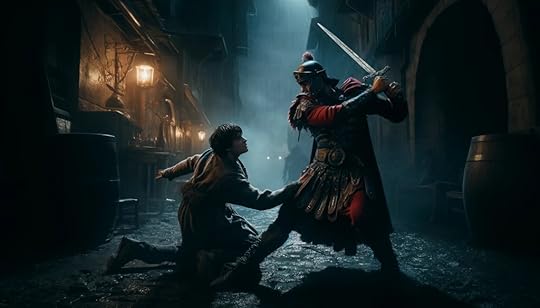
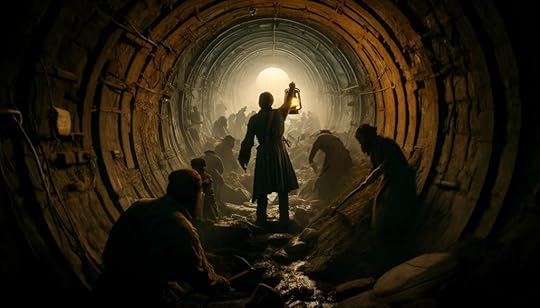 Themes
Themes Woven throughout The Rebel are themes that resonate long after you’ve turned the final page. The struggle against colonialism, the power of myth and storytelling, the nature of sacrifice—these ideas are the lifeblood of the story.
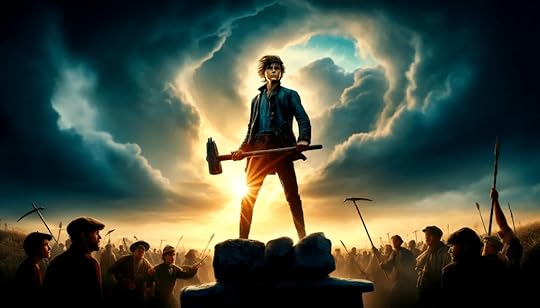 “Because these people, his people, had finally learned to stand tall, to speak out, and not accept their meager lot in life.”
“Because these people, his people, had finally learned to stand tall, to speak out, and not accept their meager lot in life.” 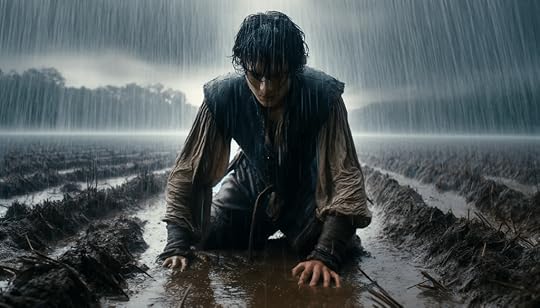 "Mud, blood, and tears - this was all that remained. For an uplander, it was the best they could hope for, the only legacy they were truly entitled to." A major theme is class conflict and oppression under colonial occupation. How does The Rebel depict the Empire’s exploitation of the uplands region? What toll does this take on the characters and their way of life?The power of storytelling and myth arises often, especially through Tegan’s Crimson Quill writings and the Ballads of Leon. Discuss the story’s meta commentary on how tales of rebels and she-wolf warriors inspire and drive real action.Sacrifice is a key motif, from Neval sacrificing his chance to leave for a better life to Erik sacrificing himself for his son to the ultimate sacrifice in the tunnel. What do you think the story is saying about the nature of sacrifice?
"Mud, blood, and tears - this was all that remained. For an uplander, it was the best they could hope for, the only legacy they were truly entitled to." A major theme is class conflict and oppression under colonial occupation. How does The Rebel depict the Empire’s exploitation of the uplands region? What toll does this take on the characters and their way of life?The power of storytelling and myth arises often, especially through Tegan’s Crimson Quill writings and the Ballads of Leon. Discuss the story’s meta commentary on how tales of rebels and she-wolf warriors inspire and drive real action.Sacrifice is a key motif, from Neval sacrificing his chance to leave for a better life to Erik sacrificing himself for his son to the ultimate sacrifice in the tunnel. What do you think the story is saying about the nature of sacrifice?The Rebel is ultimately a tragedy. What statement is the author making by denying Neval a conventionally happy or heroic ending?
SymbolismIn The Rebel, even the smallest details carry weight. The shattered remnants of Neval’s mother’s vase, a symbol of beauty broken by cruelty. The ballads of Leon, a mythic parallel to Neval and Tegan’s own doomed love. And the dam itself, a monolithic representation of Marian oppression.
The recurring Ballad of Leon verses evoke a grand, doomed romance between an ancient king and his she-wolf lover. How do the ballad’s symbols and qualities map onto Neval and Tegan’s own journey? Is their love affair given a mythic, larger-than-life quality? Does this inevitably set them up for disappointment?
The dam is a potent symbol in the story. What does it represent about Marian power, progress and oppression? On the flip side, what does its destruction by the rebels symbolize?
Neval’s mother’s ceramic vase is a small but poignant symbol of beauty, art and innocence shattered by cruelty and violence. It’s significant that Neval keeps a single shard. What does this symbolize about his character and inability to let go of the past?
Names have great symbolic significance in this story. Unpack the meanings behind names like Neval, Tegan, Rowan, Crimson Quill, Red Willow, and how they connect to each character’s qualities, flaws or fates.
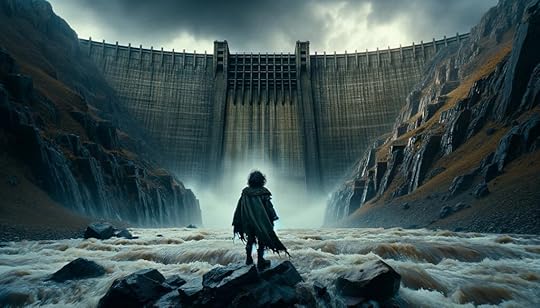 The Karthaíla Dam
The Karthaíla Dam 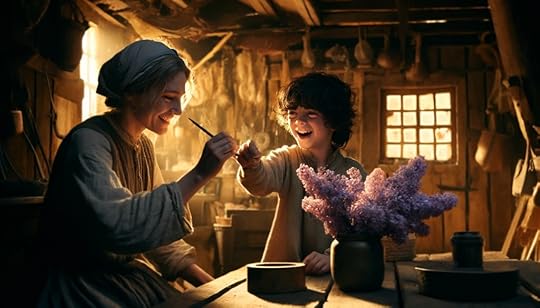 Neval and his mother Setting and Worldbuilding
Neval and his mother Setting and Worldbuilding  Ceffí
Ceffí  Port Karthaíla Ceffí is a vividly depicted upland village under Bellatorio occupation. What details make this setting come alive? How does the author convey the hardships and beauties of this place?Contrast the rural village of Ceffí with the more urban, imperialist spaces like Port Karthaíla that get mentioned. What does this world’s geography and social structure tell us about its power dynamics?The Ballads of Leon reference a distant past of mythic she-wolves and conquering kings. What do these tales within a tale reveal about the world’s history, folklore and larger conflicts?How does the Empire’s advanced infrastructure, like roads and dams, act as tools of conquest and control in the uplands? What is the significance of the rebels using more rustic weapons and hiding spaces like caves?Imagine Ceffí one year after the end of the novella. How might its physical and social landscape have changed after the dam’s destruction and Neval’s capture? What scars and seeds of new growth can you envision? For Discussion with Fellow Readers Did you connect more with Neval, Tegan or Rowan as a character? What drew you to them emotionally? And do you feel the story served them well?Are you satisfied with where the characters end up by the novella’s end? What do you imagine happens next in their journeys, or the future of Ceffí and the larger world?This story showcases H.B. Reneau’s ability to write morally complex characters, forbidden romance, and a gritty fantasy world. How does it compare to other books in the Legion of Pneumos series or by the author? What themes carry through?Did the story leave you wanting more from this corner of the Legion of Pneumos world and these characters? What other stories would you like to see?The Rebel is technically a prequel to the main Legion of Pneumos series. Did reading it first enhance your experience of the other books? Would you recommend it as an entry point to new readers?H.B. Reneau has described The Rebel as her most challenging book to write, especially Tegan’s storyline. What do you think of how the author handled the difficult subjects of oppression, violence, and a tragic heroineRespond to the James Baldwin quote that opens the Author’s Note: “You write in order to change the world, knowing perfectly well that you probably can’t, but also knowing that literature is indispensable to the world.” Do you agree? Do you see The Rebel as part of that tradition?
Port Karthaíla Ceffí is a vividly depicted upland village under Bellatorio occupation. What details make this setting come alive? How does the author convey the hardships and beauties of this place?Contrast the rural village of Ceffí with the more urban, imperialist spaces like Port Karthaíla that get mentioned. What does this world’s geography and social structure tell us about its power dynamics?The Ballads of Leon reference a distant past of mythic she-wolves and conquering kings. What do these tales within a tale reveal about the world’s history, folklore and larger conflicts?How does the Empire’s advanced infrastructure, like roads and dams, act as tools of conquest and control in the uplands? What is the significance of the rebels using more rustic weapons and hiding spaces like caves?Imagine Ceffí one year after the end of the novella. How might its physical and social landscape have changed after the dam’s destruction and Neval’s capture? What scars and seeds of new growth can you envision? For Discussion with Fellow Readers Did you connect more with Neval, Tegan or Rowan as a character? What drew you to them emotionally? And do you feel the story served them well?Are you satisfied with where the characters end up by the novella’s end? What do you imagine happens next in their journeys, or the future of Ceffí and the larger world?This story showcases H.B. Reneau’s ability to write morally complex characters, forbidden romance, and a gritty fantasy world. How does it compare to other books in the Legion of Pneumos series or by the author? What themes carry through?Did the story leave you wanting more from this corner of the Legion of Pneumos world and these characters? What other stories would you like to see?The Rebel is technically a prequel to the main Legion of Pneumos series. Did reading it first enhance your experience of the other books? Would you recommend it as an entry point to new readers?H.B. Reneau has described The Rebel as her most challenging book to write, especially Tegan’s storyline. What do you think of how the author handled the difficult subjects of oppression, violence, and a tragic heroineRespond to the James Baldwin quote that opens the Author’s Note: “You write in order to change the world, knowing perfectly well that you probably can’t, but also knowing that literature is indispensable to the world.” Do you agree? Do you see The Rebel as part of that tradition? So let’s chat, rebels. Share your thoughts, your theories, and your burning questions in the comments below! Because in the end, that’s what stories are for—to spark conversation, to make us think, to make us feel. And trust me, The Rebel will make you feel.
Until next time, keep dreaming, keep fighting, and keep reading.
Facebook Twitter Pinterest Email


